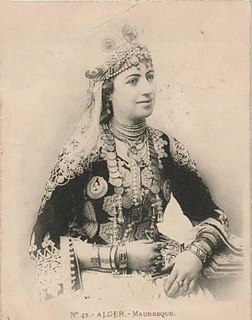 W
WThe presence of the caftan in Algeria dates far back to the Zirid period in the 10th century, the Zirid Emir would receive a caftan among other gifts from the Fatimid Caliph. Prior to the Zirid period, during the Rustamid period the great value, good reputation and significant influence of the Algerian city Tahert which was an important commercial centre attributed it the nickname “Iraq of the Maghreb” as reported by El Yakubi in the 9th century.
 W
WThe Bniqa is an embroidered shower cap that originated in Algiers.
 W
WA burnous, also burnoose, bournous or barnous, is a long cloak of coarse woollen fabric with a hood, usually white in colour, worn by the Berbers and other Maghrebis. In the Maghreb, the colour of the burnous is white, beige, or dark brown. The white burnous is worn during important events and by people with high positions.
 W
WThe chedda of Tlemcen is a traditional Algerian dress, more precisely of the city of Tlemcen, but also worn in the west of the country in particular in Oran and Mostaganem. A pure product of the Tlemcenian craftsmanship, it was worn by the Tlemcenian princesses of yesteryear.
 W
WThe Djebba Fergani is a long velvet dress adorned with elaborate embroidery and it originates from Algeria.
 W
WThe djellaba or jillaba, also written gallabea, is a long, loose-fitting unisex outer robe with full sleeves that is worn in the Maghreb region of North Africa.
 W
WThe fez, also called tarboosh, is a felt headdress in the shape of a short cylindrical peakless hat, usually red, and sometimes with a tassel attached to the top. The name "Fez" refers to the Moroccan city of Fez, where the dye to colour the hat was extracted from crimson berries. The modern fez owes much of its popularity to the Ottoman era.
 W
WThe fouta is a piece of thin patterned cotton or linen fabric of Yemeni origin used in many Mediterranean countries and Yemen. Among other uses, they were worn, by both men and women, wrapped around the body while at the public baths in 19th-century Syria. In Algeria, conservative women wore the fouta draped over their sarouel garment. Similarly, in some parts of southern Saudi Arabia, men would wear the fouta as a loincloth beneath their thawb robes, or just by itself while relaxing at home. Foutas are widely used today in the occidental world as Turkish bath towels or even beach towels. It is also used as headwear in Somalia some examples could be the Somali aristocracy, Dubats and the general Somali male population who wear it similar to a turban.
 W
WThe Frimla is a sleeveless cropped waistcoat that originated in Algeria during the 19th century, it is a variation of the Algerian Ghlila.
 W
WThe Gandoura, also Gandura, is a kind of light tunic, in wool or cotton, with or without sleeves. It normally comes in colored stripes, or more simply white, and is worn primarily in the Middle East, North Africa and West Africa where it is known by the misnomer djellaba or jalabiya. The term gandoura is Berber in origin.
 W
WThe Ghlila is a traditional Algerian jacket originating from Algeria, it is a trapezoidal jacket in velvet or brocade with a deep oval neckline, decorative buttons and enriched with embroidery notably featuring golden threads.
 W
WThe Kachabia also called Kachabiya or kchabia is a traditional Algerian Berber clothing.
 W
WThe Karakou is a long-sleeved fitted velvet jacket embroidered with golden and silvered threads, it is a traditional Algerian garment originating from Algiers.
 W
WThe M’laya is a black veil that covers the whole body, it originated in Algeria.
 W
WA qashabiya is a traditional berber Algerian garment most often associated with the Chaoui, and those from Djelfa. It is made of camel hair and wool, and is held in high esteem by many Algerians because of the warmth it provides during cold winters, especially in the high plateaus of the Chaouia region where it is produced.
 W
WThe Sarma or Serma is a cone-shaped metallic headdress that originated in Algiers.
 W
WThe taqiyah or araqchin is a short, rounded skullcap. It is often worn for religious purposes; for example, Muslims believe that the Islamic prophet Muhammad used to keep his head covered, therefore making it mustahabb. Muslim men often wear them during the five daily prayers.